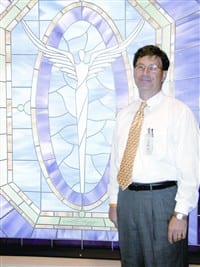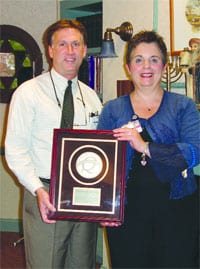‘Journey Of Hope’ Sr. Caritas Cancer Center Will Focus On Thorough Patient Care
Cancer brings uncertainty into anyone’s life. But one thing that Frank Claudio is certain of is that when people are faced with cancer, they don’t want treatment that is simply ‘good enough.’
That belief became the pervasive theme as Mercy Medical Center’s Sr. Caritas Cancer Center was designed and constructed, and Claudio, the center’s director, said the goal of offering the best care possible to patients will remain its driving force.
The center is nearing completion and is slated to open on Tuesday, Oct. 26.
“One thing we never want to lose sight of is that we offer compassionate, high-quality care,” said Claudio, “and the center’s design reflects that. Everything here, in essence, is designed to help the patient.”
A path painted on the floor in soft colors – blues, violets, and greens — and lined with tinted windows and skylights begins at a private entrance in the rear of Mercy Medical Center and was planned to make a visit to the building as simple and calming as possible. In short, Claudio said the design represents a ‘journey of hope.’
“We kept in mind what people value,” Claudio said. “The natural lines, diffused light, and cool colors — they can all help the patient. We kept curves and lines constant throughout the entire center. It’s all designed to be modern and functional, too; in this space, patient care and design go hand in hand.”
Artistic Integrity
A patient’s journey begins in one of two waiting rooms, where a large stained glass window depicting an angel greets visitors. The one-of-a-kind window was created by nationally-known artist Steven Lavaggi, who specializes in inspirational sculptures, murals, and paintings. All staff areas are out in the open so patients always have contact person close at hand, including a full-time staff member of the American Cancer Society, who will work directly from the center in order to provide services for patients on site.
“This is the first time this has ever been done at Mercy,” Claudio said. “We’re trying to forge a more unified relationship with ACS, so patients can receive services more easily.”
A door framed by frosted glass leads into the clinical area of the cancer center, where a series of rooms offer quiet comfort for patients in need of explanation, information, or just a place to regroup. The Pastoral Care, Patient Care, Education and ‘Quiet’ Rooms are all housed in a private corridor, and were included in the center’s design to ensure that a patient’s resources include not only treatment, but solace as well.
Throughout the center, natural light has been incorporated to maintain an atmosphere that promotes the same protected feeling as the private rooms, and strays from the clinical feel of most medical centers. “Nothing looks like a hospital here,” Claudio said. “Patients should feel as comfortable as possible, it’s one of the steps of the process. There should be no surprises.”
The goal of reducing the stress and fear of a visit to the cancer center extends to the treatment rooms, which Claudio said are traditionally intimidating to anyone.
canning and treatment equipment are most often massive contraptions, and radiation machines require closing 36,000-pound doors when in use. Mercy has taken steps to camouflage the equipment with strategic walls and cabinet doors that hide as much of the hardware as possible. Treatment tables are lower than most patients are used to, in an effort to ease getting on and off, and bathrooms have been placed adjacent to treatment rooms so patients don’t have to walk through the center in dressing gowns. Back-lit photos of pastoral scenes have also been mounted on walls and ceilings, giving patients a focal point during treatment. All of the photos were chosen by a focus group composed of patients in Mercy’s older cancer center, Claudio said.
Technical Merit
The center’s unique design elements are not the only aspect that Claudio is proud of, however; the artfully painted walls house one of the most state-of-the-art cancer center treatment facilities in the region, including a CT scan and simulator system, a treatment planning area, in which specialists process the information gleaned from scans and determine the best course of therapy, and two linear accelerators, or Linacs – radiation-treatment machines that are equipped to treat patients with the newest technology available.
The Linacs can treat a patient in one of two ways – using 3-D Conformal Radiation Therapy, the industry standard, or Intensity Modulated Radiation Therapy (IMRT), a radiation method that can pinpoint a cancerous area more accurately and reduce the spread of radiation to healthy tissue.
IMRT is not a replacement for 3-D conformal, according to Tim Klapproth, a certified medical dossimetrist at the cancer center, but rather is a very technical enhancement that is still being studied nation-wide so it can be used in the most effective way possible.
“3-D conformal is considered the Cadillac of radiation treatment,” Klapproth said, “Whereas IMRT is the Mercedes 760. It’s meant to be an enhancement such as to provide the maximum potential for cure in cancer cases that warrant such treatment.”
Further, IMRT reduces the variation of radiation absorption levels across a targeted area. A cancerous tumor, for example, could receive varying levels of radiation using the 3D conformal method ranging from very low levels to very high levels; the more precise IMRT delivers a constant level. IMRT is also not typically used for more advanced cancer cases, Klapproth said, but rather is more beneficial to patients with early-stage tumors. Offering IMRT at the Sr. Caritas Cancer Center will, therefore, provide the best possible chance to patents with early-stage cancers to stop the disease in its tracks.
“As a community hospital, it’s a primary goal to prevent damage,” he said. “It’s a quality-of-care issue, and this improves our quality. Having IMRT allows us to stay right on the edge of cancer treatment for this community.”
Regardless of what treatment option is chosen by the cancer center team, though, a patient’s treatment experience is driven by the treatment-planning room, which connects and controls all of the patient’s information from start to finish. Klapproth calls the planning area the hub of the wheel, while the differentservices at the center are the spokes.
“The whole system is very technically driven,” he said, adding that CT Simulator information on a patient is fed to the treatment planning area via a digital scanning system called Pinnacle (Klapproth said the system is ranked number one in the industry) then analyzed by a dossimetrist and a physician. The information and a proposed treatment plan is then fed into a digital patient record system, which is in turn sentto the Linac room to be utilized.
“We have everything on the patient. It enables us to analyze a patient’s treatment and also gives us three points at which information can be checked and rechecked.”
“Everything ultimately comes back to quality of care,” added Claudio. “Just one treatment — one person — could have 15 people working with them in one day and that doesn’t include the people behind the scenes. The technology and the people running it make the most optimal plan for every patient.”
A New Chapter
At the end of a patient’s treatment, after they have traveled through the entire center, the building’s cyclical design directs the patient to the same point at which they began, a starting point as well as a finish line, capped with a pyramid-shaped skylight.
When the center opens in October, it will have effectively doubled the size and scope of Mercy’s cancer services. The project carried an $8.6 million price tag, but as Claudio repeated throughout a tour of the facility, ‘good enough’ was not enough for him or the center’s staff.
“When it’s your mother, your brother, your sister, your friend, you don’t want ‘good enough.’ You want the best care you can possibly receive. And I really believe we will offer the best care.”




Comments are closed.